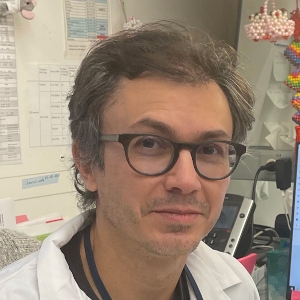Luis Fernando Menezes, M.D., Ph.D.

Professional Experience
- Staff Scientist, NIDDK, NIH, 2012–Present
- Postdoctoral Fellow, NIDDK, NIH, 2009–2012
- Postdoctoral Fellow, Johns Hopkins School of Medicine, 2005–2009
- Residency in Human Pathology, School of Medicine, University of São Paulo, Brazil, 1999–2001
- Ph.D., School of Medicine, University of São Paulo, Brazil, 2004
- M.D., School of Medicine, State University of Campinas, Campinas, Brazil, 1998
Research Goal
The purchase of this research is to determine the mechanisms and factors that establish and maintain tubular diameter, to understand the pathobiology of polycystic kidney disease (PKD) and to use this information to find a therapy for PKD.
Current Research
Autosomal Dominant Polycystic Kidney Disease (ADPKD) is caused by mutations in PKD1 (approximately 85 percent) or PKD2 (approximately 15 percent) and is the most common genetic cause of PKD. It is mainly characterized by cystic dilatation of the kidney and biliary tubular epithelium. Our focus is to understand how these genes are involved in the establishment of normal tubular diameter and how their inactivation leads to cyst formation. To this end, we currently use several (conditional) knock-out mice and cell lines to study gene expression patterns, metabolic profiles, protein interactions, intracellular trafficking, and signaling pathways.
Applying our Research
PKD is a common cause of end-stage renal disease. Understanding and treating it can result in significant benefits to patients.
Need for Further Study
While the PKD gene products polycystin 1 (PC1) and polycystin 2 (PC2) are known to be essential for establishing and maintaining normal tubule structure, we do not know what they do. Several lines of evidence suggest that they function as a receptor-channel complex, but what they sense and signal is poorly understood. Though numerous pathways have been reported to be dysregulated in cystic epithelia, it is unclear how these link back to the function of the PC1/PC2 complex, which pathways are dysregulated at the earliest stages of cyst formation, and which are altered as secondary consequence of cystic dilations. We also do not understand why cysts form immediately after gene inactivation in young mice, but take months to arise in older animals. What factors preserve tubular structure during this interval, and what triggers the subsequent failure? Finally, we have identified a fragment of PC1 that can alter mitochondrial function and morphology, but further studies are required to determine how and if/how this mitochondrial dysfunction results in cyst formation. Understanding these processes is important not only from a pathobiological standpoint, but also to design more specific therapies and identify biomarkers of early progression.
Select Publications
- A novel ARPKD mouse model with near-complete deletion of the Polycystic Kidney and Hepatic Disease 1 (Pkhd1) genomic locus presents with multiple phenotypes but not renal cysts.
- Ishimoto Y, Menezes LF, Zhou F, Yoshida T, Komori T, Qiu J, Young MF, Lu H, Potapova S, Outeda P, Watnick T, Germino GG.
- Kidney Int (2023 Sep) 104:611-616. Abstract/Full Text
- In vivo Polycystin-1 interactome using a novel Pkd1 knock-in mouse model.
- Lin CC, Menezes LF, Qiu J, Pearson E, Zhou F, Ishimoto Y, Anderson DE, Germino GG.
- PLoS One (2023) 18:e0289778. Abstract/Full Text
Research in Plain Language
An important component of the kidney are the tubes that make urine. These tubes, as the name implies, are usually long channels through which the urine flows. In polycystic kidney disease (PKD), these tubes start to dilate and can become large balloons (cysts) filled with fluid. Sometimes they are disconnected from the other tubes, are no longer capable of making urine and compress and damage nearby tubes. This results in the kidney not working properly. We study the mechanisms responsible for the tubes becoming cystic using genetically engineered mice that have PKD and cell lines that mimic some of the characteristics of PKD.
